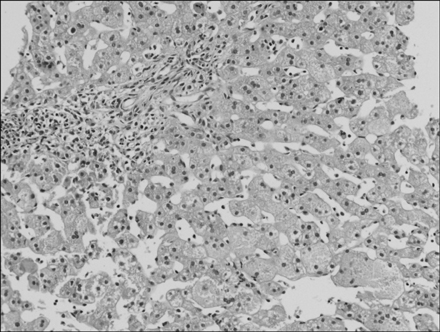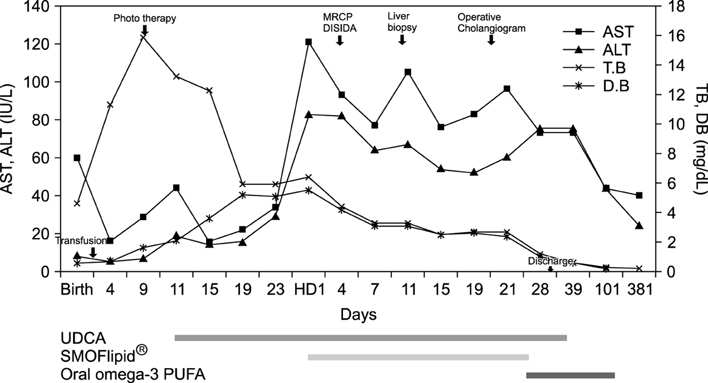Pediatr Gastroenterol Hepatol Nutr.
2016 Dec;19(4):286-290. 10.5223/pghn.2016.19.4.286.
Use of Omega-3 Polyunsaturated Fatty Acids to Treat Inspissated Bile Syndrome: A Case Report
- Affiliations
-
- 1Department of Pediatrics, Konkuk University Medical Center, Seoul, Korea. baedori@hanafos.com
- 2Department of Pediatric Surgery, Konkuk University Medical Center, Seoul, Korea.
- 3Department of Pathology, Konkuk University Medical Center, Seoul, Korea.
- KMID: 2364771
- DOI: http://doi.org/10.5223/pghn.2016.19.4.286
Abstract
- Inspissated bile syndrome (IBS) is a rare condition in which thick intraluminal bile, including bile plugs, sludge, or stones, blocks the extrahepatic bile ducts in an infant. A 5-week-old female infant was admitted for evaluation of jaundice and acholic stool. Diagnostic tests, including ultrasound sonography, magnetic resonance cholangiopancreatography, and a hepatobiliary scan, were not conclusive. Although the diagnosis was unclear, the clinical and laboratory findings improved gradually on administration of urodeoxycholic acid and lipid emulsion containing omega-3 polyunsaturated fatty acids (PUFAs) for 3 weeks. However, a liver biopsy was suggestive of biliary atresia. This finding forced us to perform intraoperative cholangiography, which revealed a patent common bile duct with impacted thick bile. We performed normal saline irrigation and the symptom was improved, the final diagnosis was IBS. Thus, we herein report that IBS can be treated with omega-3 PUFAs as an alternative to surgical intervention.
MeSH Terms
-
Bile Ducts, Extrahepatic
Bile*
Biliary Atresia
Biopsy
Cholangiography
Cholangiopancreatography, Magnetic Resonance
Cholestasis
Common Bile Duct
Diagnosis
Diagnostic Tests, Routine
Fatty Acids, Omega-3
Fatty Acids, Unsaturated*
Female
Humans
Infant
Jaundice
Liver
Sewage
Ultrasonography
Fatty Acids, Omega-3
Fatty Acids, Unsaturated
Sewage
Figure
Cited by 1 articles
-
Percutaneous Transhepatic Biliary Drainage in a Two-Month-Old Infant with Inspissated Bile Syndrome
Sung Hui Chang, Seung-Moon Joo, Choon-Sik Yoon, Kwang-Hun Lee, Soon Min Lee
Yonsei Med J. 2018;59(7):904-907. doi: 10.3349/ymj.2018.59.7.904.
Reference
-
1. Bernstein J, Braylan R, Brough AJ. Bile-plug syndrome: a correctable cause of obstructive jaundice in infants. Pediatrics. 1969; 43:273–276.
Article2. Lightwood R, Bodian M. Biliary obstruction associated with icterus gravis neonatorum. Arch Dis Child. 1946; 21:209–217.
Article3. Heaton ND, Davenport M, Howard ER. Intraluminal biliary obstruction. Arch Dis Child. 19911; 66:1395–1398.
Article4. Berger S, Schibli S, Stranzinger E, Cholewa D. One-stage laparoscopic surgery for inspissated bile syndrome: case report and review of surgical techniques. Springerplus. 2013; 2:648.
Article5. Gunnarsdóttir A, Holmqvist P, Arnbjörnsson E, Kullendorff CM. Laparoscopic aided cholecystostomy as a treatment of inspissated bile syndrome. J Pediatr Surg. 2008; 43:e33–e35.
Article6. Jonkers IJ, Smelt AH, Princen HM, Kuipers F, Romijn JA, Boverhof R, et al. Fish oil increases bile acid synthesis in male patients with hypertriglyceridemia. J Nutr. 2006; 136:987–991.
Article7. Kamisako T, Tanaka Y, Ikeda T, Yamamoto K, Ogawa H. Dietary fish oil regulates gene expression of cholesterol and bile acid transporters in mice. Hepatol Res. 2012; 42:321–326.
Article8. Davenport M, Betalli P, D'Antiga L, Cheeseman P, Mieli-Vergani G, Howard ER. The spectrum of surgical jaundice in infancy. J Pediatr Surg. 2003; 38:1471–1479.
Article9. Gubernick JA, Rosenberg HK, Ilaslan H, Kessler A. US approach to jaundice in infants and children. Radiographics. 2000; 20:173–195.
Article10. Lang EV, Pinckney LE. Spontaneous resolution of bile-plug syndrome. AJR Am J Roentgenol. 1991; 156:1225–1226.
Article11. Jee KB, Song JY, You KY, Min KS, Kim DH, Lee KS. A case of spontaneous resolution of bile plug syndrome in a 4-year-old girl. Korean J Pediatr Gastroenterol Nutr. 1999; 2:262–266.
Article12. Nandivada P, Cowan E, Carlson SJ, Chang M, Gura KM, Puder M. Mechanisms for the effects of fish oil lipid emulsions in the management of parenteral nutritionassociated liver disease. Prostaglandins Leukot Essent Fatty Acids. 2013; 89:153–158.
Article13. Bae SH, Park HS, Han HS, Yun IJ. Omega-3 polyunsaturated fatty acid for cholestasis due to bile duct paucity. Pediatr Gastroenterol Hepatol Nutr. 2014; 17:121–124.
Article14. Bérard AM, Dumon MF, Darmon M. Dietary fish oil up-regulates cholesterol 7alpha-hydroxylase mRNA in mouse liver leading to an increase in bile acid and cholesterol excretion. FEBS Lett. 2004; 559:125–128.
Article
- Full Text Links
- Actions
-
Cited
- CITED
-
- Close
- Share
- Similar articles
-
- Omega-3 Polyunsaturated Fatty Acid for Cholestasis due to Bile Duct Paucity
- Polyunsaturated Fatty Acids in Children
- Letter to the Editor: Effects of Omega-3 Fatty Acids on Erectile Dysfunction in a Rat Model of Atherosclerosis-induced Chronic Pelvic Ischemia
- Omega-3 and Menopause
- Association between Omega Fatty Acid Intake and Suicidality : Sex Differences in the General Korean Population




